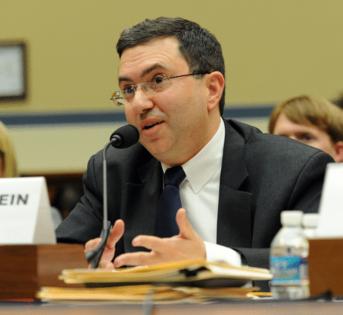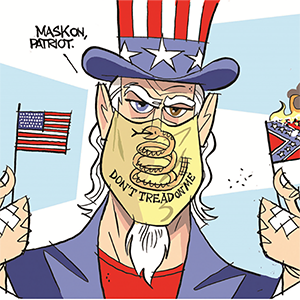Former Baltimore health commissioner, Maryland health secretary testifies in city's opioid trial: 'We were on the right trajectory'
Published in News & Features
BALTIMORE — Dr. Joshua Sharfstein took over the Baltimore City Health Department in 2005 at a time when heroin-related overdose deaths were declining, and one of his chief responsibilities under then-Mayor Martin O’Malley was to further reduce them.
Sharfstein spearheaded an initiative to expand access to buprenorphine, an opioid drug used to treat heroin withdrawal, and overdose deaths declined to about 100 by 2009. That was the year Sharfstein resigned as city health commissioner, having been appointed by former President Barack Obama to lead the U.S. Food and Drug Administration.
From a peak of 312 heroin deaths in 1999, Baltimore achieved a low of 76 such fatalities in 2011, when Sharfstein’s attention returned to the city, this time as Maryland health secretary, again under O’Malley, who had been elected governor.
But soon after his return to Maryland, Sharfstein testified Thursday in Baltimore Circuit Court, he and other health officials noticed a concerning trend. Under his leadership, the state health department sent a letter Dec. 7, 2012, to every physician in Maryland, asking for their help.
“Over the past decade, a growing epidemic of prescription drug abuse has led to a significant increase in pharmaceutical-related overdose deaths, often involving opioid analgesics prescribed by a physician,” read the letter, which was displayed in court. “Improved controls over these drugs and improved prescribing practices have been implemented to counter this trend.”
While prescription drug deaths were declining at the time, heroin deaths were on the rise again, the letter continued.
“One potential explanation is that individuals who are having a harder time obtaining prescription drugs for non-medical use are initiating heroin use,” it read.
Sharfstein was the first person to take the witness stand in Baltimore’s long-anticipated civil case against drug distribution companies McKesson and AmerisourceBergen. The city alleges those companies alone sent hundreds of millions of addictive pain pills to Baltimore from 2006 to 2019, with little regard for the havoc they would wreak.
Describing Baltimore’s crisis as “the worst opioid epidemic in America,” a city attorney in opening statements Wednesday accused the drug distributors of overlooking “suspicious orders” called in by “pill mill” doctors.
In doing so, Bill Carmody said, the companies created a new generation suffering from addiction, people who went on to die at unprecedented rates when their subscriptions ran out and they turned to an illicit drug market inundated with deadly fentanyl, a synthetic opioid even more lethal than heroin.
Sharfstein’s testimony both bolstered the city’s case and previewed the companies’ strategies for combating it.
“We were on the right trajectory,” Sharfstein said, “until something came along and knocked us off.”
In opening statements, attorneys for McKesson and AmerisourceBergen said their companies merely provided opioids and other drugs to licensed pharmacies filling prescriptions from doctors. They blamed cartels, gangs and drug crews for bringing heroin and fentanyl to Baltimore, pointing to the criminal element as the source of the overdose crisis.
“As health commissioner, did you look at who was selling illicit street drugs?” Timothy C. Hester, an attorney for McKesson, asked Sharfstein.
“Not particularly,” said Sharfstein.
Through his questioning, Hester pointed out that the vast majority of opioid-related deaths included in a health department chart breaking down such fatalities from 1995 to 2006, were attributable to heroin rather than prescription opioids. He also asked if Sharfstein, when he was health secretary, was concerned about doctors overprescribing opioids.
“I was concerned about the prescription drug epidemic in Maryland, which included overprescribing,” replied Sharfstein, who now works at the Johns Hopkins Bloomberg School of Public Health, and advises Baltimore Mayor Brandon Scott about health policy in a part-time capacity.
City attorneys also asked Sharfstein about a Jan. 31, 2014, health department news release warning of a “potent and deadly drug combination” discovered during autopsies. The announcement was raising an alarm about heroin tainted with fentanyl.
“That made us extremely worried. … We knew at the time there were a lot of people with opioid addiction,” Sharfstein recalled.
The city contends that the distributors’ actions amounted to a public nuisance that deprived residents of their right to health and safety. For the jury to hold the companies liable, Circuit Judge Lawrence P. Fletcher Hill explained to jurors Thursday, the city has to prove that “one or both of the defendants” caused the public nuisance.
To further support its case, the city called Yolanda Cason, of the Department of Public Works’ Bureau of Solid Waste, and Rania Mohamed, of the city health department, to testify about their work trying to keep the city clean in the face of the opioid crisis and to help the people trapped in the vicious cycle of addiction.
Cason, who has worked for the public works department for 31 years, said she didn’t see many signs of addiction growing up in Baltimore, but “now you see it everywhere.”
“It’s been really, really hard trying to keep the city clean,” said Cason, noting that her team has to respond to soiled mattresses, drug paraphernalia and human waste daily.
She said it’s become such a problem that her agency had to contract a biohazard waste company and purchase puncture- proof gloves to avoid employees being stabbed by used needles.
“In those areas you see drug use,” Cason said, “there’s a lot more trash.”
Mohamed, meanwhile, spoke about the health department’s syringe services and opioid reversal programs, which have distributed 17.6 million clean syringes over the last 30 years and reversed more than 7,000 overdoses over the past 20, respectively.
She testified about the lengths the health agency goes to to help people with opioid addiction, including mobile clinics tailored to provide them resources and treat their wounds, as well as partnerships created to provide them substance abuse help and wraparound resources, such as housing aid.
“It’s really important that we don’t ignore and leave people behind because they’re suffering from a disease,” Mohamed said.
Megan L. Rodgers, an attorney for McKesson, suggested in her questioning of Mohamed that syringe services were only for those who used illicit drugs. She also confronted Mohamed with a health department strategic plan to address the opioid epidemic in Baltimore.
“Wholesale distributors are not mentioned, are they?” Rodgers asked.
“They are not directly mentioned,” Mohamed responded, “but that does not mean there’s no connection.”
_______
©2024 The Baltimore Sun. Visit at baltimoresun.com. Distributed by Tribune Content Agency, LLC.







Comments